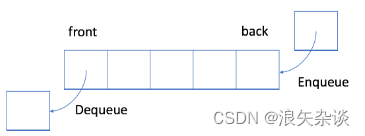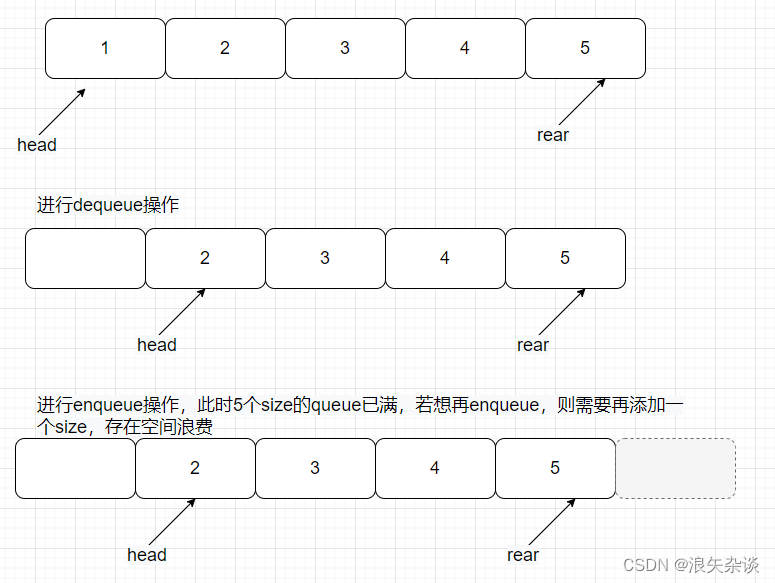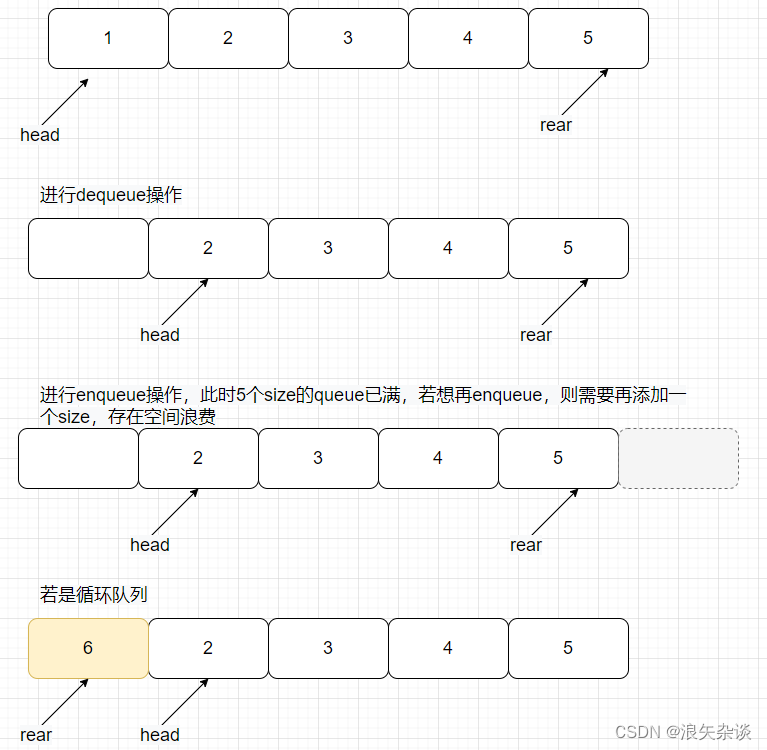本期主题:
先进先出队列实现
1.队列定义
队列是什么?定义:
- 一个先进先出的数据结构
- 插入操作称为入队(enqueue),入队始终在
队尾添加元素
- 删除操作称为出队(dequeue),出队操作始终从
队头开始

2.实现一个简单的队列以及分析
1.代码实现分析
先分析该怎么实现队列,其实前面描述了就三个特点,一一分析:
插入操作在队尾实现,使用vector的push_back接口,直接在动态数组尾部实现添加;
删除操作从队头开始,这个需要有一个位置指针,告诉我们现在头部在哪里,然后每次出一个,头部位置就++;
2.code
按如下分析完之后,我们可以实现代码了:
class MyQueue {
private:
// store elements
vector<int> data;
// a pointer to indicate the start position
int p_start;
public:
MyQueue() { p_start = 0; }
/** Insert an element into the queue. Return true if the operation is successful. */
bool enQueue(int x) {
data.push_back(x);
return true;
}
/** Delete an element from the queue. Return true if the operation is successful. */
bool deQueue() {
if (isEmpty()) {
return false;
}
p_start++;
return true;
};
/** Get the front item from the queue. */
int Front() {
return data[p_start];
};
/** Checks whether the queue is empty or not. */
bool isEmpty() {
return (p_start >= data.size());
}
};
完整代码:
int main() {
MyQueue q;
q.enQueue(5);
q.enQueue(3);
if (!q.isEmpty()) {
cout << q.Front() << endl;
}
q.deQueue();
if (!q.isEmpty()) {
cout << q.Front() << endl;
}
q.deQueue();
if (!q.isEmpty()) {
cout << q.Front() << endl;
}
}
输出结果:

3.优缺点分析
优点:
代码简单,非常好实现
缺点:
存在假满的情况,效率低,有空间浪费情况存在
我们看一个例子:
假设我们定义一个size为5的queue,第一步我们先dequeue,然后再enqueue,会发现此时这个queue已经满了,但实际上有效的数据只有4个

3.循环队列实现
1.循环队列原理
针对上面提到的效率低、空间利用有限的问题,更好的方案是使用一个循环队列,即头和尾能够连在一起,如下图所示:

2.循环队列实现分析
循环队列实现需要分析以下几点:
- 首先,肯定是需要两个位置变量,来表明当前的头和尾
- 判断队列空条件分析:空的时候,头和尾都应该指向非当前数据区域,当头=尾时,应该是只剩了最后一个元素
- 判断队列满条件分析:满的时候,尾+1=头,但是有循环回来的问题,所以应该是 (尾+1)%(整个size)=头
3.code
class MyCircularQueue {
public:
vector<int> data;
int head_pos = -1;
int rear_pos = -1;
int size = 0;
MyCircularQueue(int k) {
data.resize(k);
size = k;
}
bool enQueue(int value) {
if (isFull()) {
return false;
}
if (isEmpty()) {
head_pos = 0;
}
rear_pos++;
rear_pos = rear_pos % size;
data[rear_pos] = value;
return true;
}
bool deQueue() {
if (isEmpty()) {
return false;
}
if (head_pos == rear_pos) {
head_pos = -1;
rear_pos = -1;
return true;
}
head_pos++;
head_pos = head_pos % size;
return true;
}
int Front() {
if (isEmpty()) {
return -1;
} else {
return data[head_pos];
}
}
int Rear() {
if (isEmpty()) {
return -1;
} else {
return data[rear_pos];
}
}
bool isEmpty() {
return (head_pos == -1);
}
bool isFull() {
return ((rear_pos + 1) % size == head_pos);
}
};